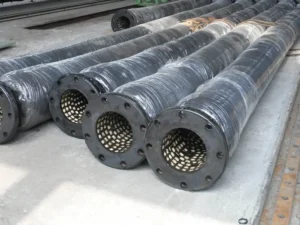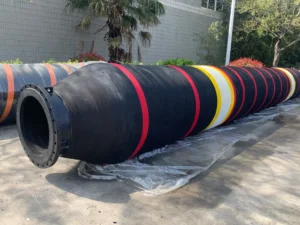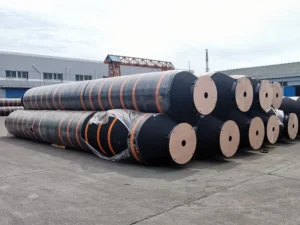When choosing a suitable dredge hose, a few factors come into play. The types, specs, constructions, compatibility, technical support, and budget are the most crucial.
This article briefly discusses these factors. After reading it, we hope you can choose a suitable dredge hose for your project.
What is Dredge Hose?
A dredge hose is a unique type of hose. As the name suggests, it is mainly prevalent for dredging applications. Its primary job is transporting sand, slurry, and gravel from one place to another. Most scenarios use it from a dredging vessel to a disposal area.
Since these hoses transport abrasive materials, their construction must be robust. A dredge hose’s typical structure has three primary layers.
Inner Layer or Tube
This layer is in direct contact with the transported material. It plays a crucial role in smooth transportation. However, its primary role is to provide sufficient resistance to abrasion and corrosion.
Reinforcement Layers
You will find these layers between the inner and outer layers. The number of layers may vary depending on the type. However, they are generally made of metals or synthetic fibers. Their main job is to provide structural integrity and prevent the hose from collapsing under pressure.
Outer Layer or Cover
This layer keeps the reinforcement layers safe from damage from the outside. The upper cover makes it more resistant to wear and tear, weathering, and UV light.
What Should You Consider When Selecting a Dredge Hose
As mentioned, dredge hoses are mainly prevalent for dredging operations. They transfer materials from water bodies like rivers, lakes, and harbors. In addition, you may often find its use in land reclamation activities.
Moreover, dredge hoses are used extensively in mining. They are essential in underwater mining for gold or diamonds. Dredge hoses also help clean up the surroundings. Taking out sediment or other harmful substances from water sources is a typical example.
We can realize how vital the dredge quality is in these applications. So, you must consider a few factors when picking a dredge hose for your job.
Dredging Hose Types: Which One Is the Right Option for Your Project?
Picking the correct dredging hose is very important for the success of any dredging job. Different kinds of dredge hoses are used for various tasks and situations. Knowing about each type can help you make an informed decision. Usually, we can find three main types of dredge hoses.
Type #1 Dredge Suction Hose

The dredge suction hose is one of the most popular in dredging operations. As the name suggests, its design can handle suction or vacuum pressures. It is vital in moving sand, slurry, and sediment from underwater.
The construction of these suction hoses is reinforced with high-strength materials. They are typically not designed to float but for underwater suction operations. They usually have a smooth inner rubber layer for efficient material flow.
Type #2 Floating Dredge Hose

As the name suggests, these pipes can float, which the other types can not. It defines their construction as having buoyancy elements. Other constructions may also use special nonabsorbable and unsinkable foam.
Floating dredging hoses are highly flexible and prevalent for many purposes. The structure can handle specific thrusts when moving materials.
When looking for a floating dredge pipe, you should always consider how much buoyancy you need. Next, consider how well it will work with the dredging tools and the operation conditions.
Type #3 Dredge Discharge Hose

As the name suggests, these hoses move materials from the vessel to the disposal area. Usually, you can find these hoses connected to a pump on a ship. So, it must handle the pressure generated by the pumps.
They have a more robust structure that can handle the pressure & wear from discarded materials. In most cases, they don’t float.
Dredge discharge hoses are used beneath or on the seabed. They are mainly made for discharge on or offshore. Dredge discharge hoses may have extra layers to make them more resistant to wear and oil.
Other Types

In addition to the types mentioned above, there are other specialized dredging hoses.
The jetting dredge pipe is famous for high-pressure water jetting. These dredge hoses are used to break up and loosen packed objects.
Armored dredging hoses are tough and specially built to endure sharp rocks and debris. Their construction often includes a steel wire helix for extra strength.
Another kind of dredge tube is corrugated. It’s great for tight places. Dredging hoses that float independently don’t need any extra gadgets to help them float. Heat-resistant dredging lines are prevalent for high-temperature applications.
Dredge Hose Construction & Compatibility: Can it Handle Your Project Needs?
Dredger hose design is critical for maritime uses. Its robust construction tells you how well it can operate in hazardous environments.
If you observe the cross-section of the dredge hose, you will notice multiple layers. In most cases, strong materials are used for these layers. Rubber and reinforced materials are the most common in this case. However, these layers typically maintain a smooth dredging job.
On the other hand, consistency is another crucial thing to consider. It ensures that the flexible dredge hose can quickly move the materials. For instance, when sand is discharged, the hose must handle wear and tear.
Hose Specification: Working Pressure, Diameter, Length, Temperature and Thickness
Next, look at the product’s details. Does it meet the needs of your application? What kinds of measurements are used? Remember that each spec tells you if the hose can be used for a particular job. Working pressures & temperatures, sizes, and thicknesses are the critical parameters to consider here.
Working Pressure
This value tells you the highest pressure the hose can withstand during operation. Always pick the safe value for pressures. Know the pump’s highest output pressure. Then, keep a secure boundary for the pressure rating. This can ensure that your hose won’t fail because of pressure.
Temperature
Dredging activities can happen in many different types of weather, and the weather changes quickly. Sometimes, it’s above 40 degrees Celsius, and other times, it’s below -20 degrees. For the hose to work correctly, the material and design must be able to handle these temperatures.
Diameter
The diameter of the hose determines the volume of material it can transport. Selecting the correct diameter is essential for achieving the desired flow rates. Note that smaller diameters can increase pressures and lead to failure.
Thickness
Hose thickness is another important spec. It directly affects the hose’s durability. Always choose the appropriate thickness. Note that most dredging jobs involve hazardous situations, so the thickness of the material plays a crucial role here.
As you know, three types of dredging hoses are prevalent in most marine operations. They are floating dredge hose, suction dredge hose, and discharge dredge hose. You can click on the names to go directly to the products page. Take a tour to learn more about them. You can also check the different specifications of each type.
Custom Manufacturing: Dredge Hose Custom Sizes and Features
You might be looking for a custom size, features, and certificate for a dredge hose. This is a typical case for rubber hoses. Here comes the world of custom manufacturing.
Custom manufacturing has become popular recently. It allows you to customize your products based on your project requirements. Above all, it also builds the customer’s trust.
Standard sizes are often used in many applications, but these hoses may not be the best fit in some cases. Because of this, custom dredge hose sizes and features are so important. They ensure your hose fits perfectly with your project. Therefore, when choosing a suitable dredge hose, consider this factor as well.
When might you need a custom dredge hose? You may need this for deep-sea dredging, especially for offshore projects. Custom dredge hoses are also critical in industrial mining operations.
In a dredge hose, what can you change? You can change the size, materials, and the reinforcement. You can also ask for different quality standards and tests.
On the other hand, not all companies offer custom manufacturing. Only a few can, like Rentone Hose. Since custom manufacturing may slow down production, many companies don’t take custom orders. Besides, this also requires special tools and expertise.
Technical Support & Budget
Finally, the budget and the quality of the customer support should be considered. Two important factors come into play when considering the cost.
The initial cost is when you purchase a package from a company. On the other hand, the ownership cost is the total cost of using the hose. The TOC may also include the maintenance and repair costs. When selecting the quality of the dredge hose, balance the price with the long-term performance.
However, customer support is another vital factor. Why this is so necessary? It gives you reliable guidance and education. You can communicate with the customer support team on time. A technical support team is also essential for custom solutions. You can thereby clearly tell them what you need.
Final Thought
Dredge hoses are critical in marine applications. They are widely used to discharge seawater, silt, and sand. We often need them in rivers, lakes, harbors, and coaster areas. They may also be used in the construction of ports and airports.
So, you can realize that dredge hose often works in high-pressure applications. A single mistake can lead to a hazardous situation. Therefore, when choosing a dredge hose, always consider the above-mentioned factors.
If you need expert assistance or custom solutions, contact us today. Our dedicated customer support team is here to address your needs promptly.
